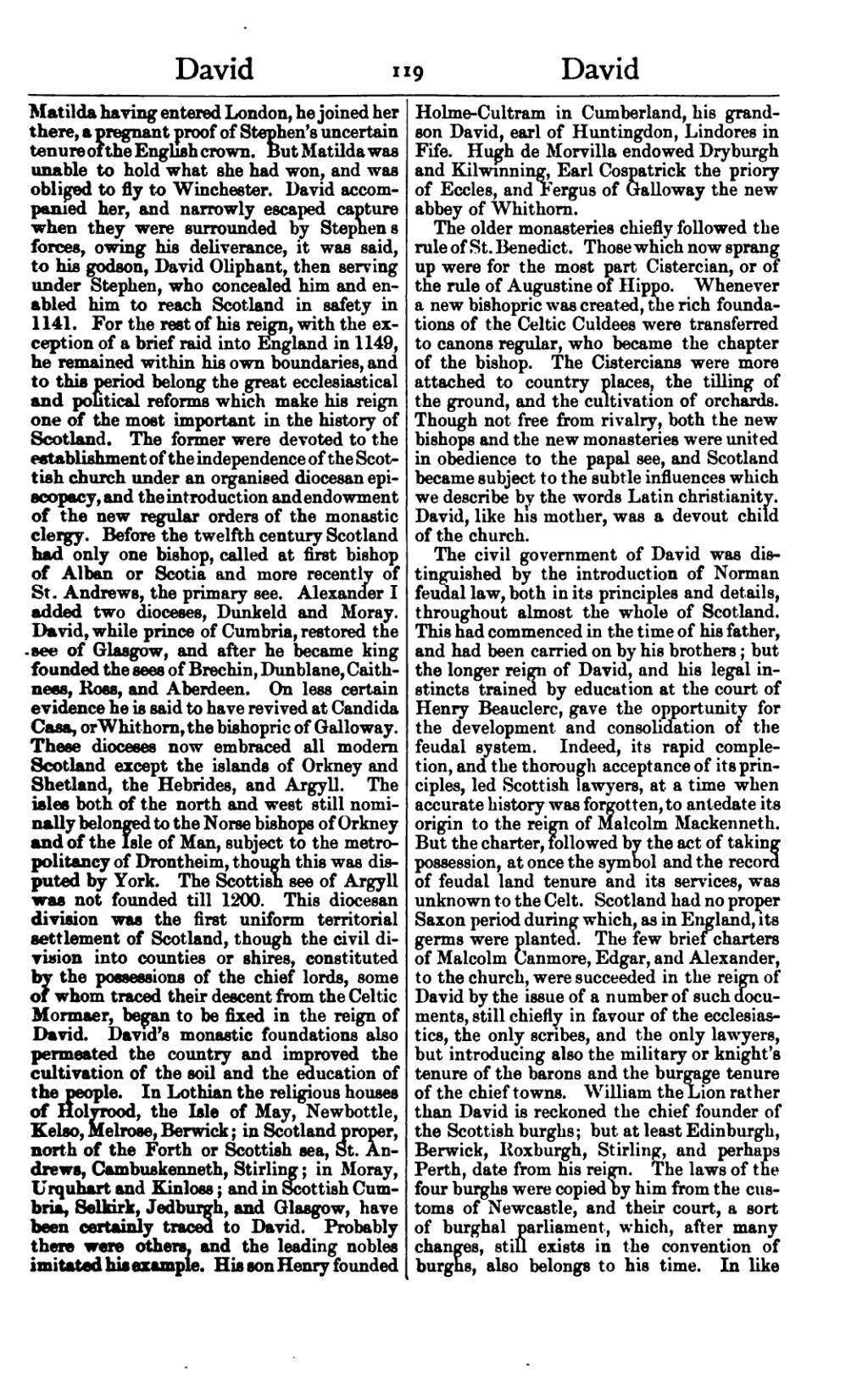Matilda having entered London, he joined her there, a pregnant proof of Stephen's uncertain tenure of the English crown. But Matilda was unable to hold what she had won, and was obliged to fly to Winchester. David accompanied her, and narrowly escaped capture when they were surrounded by Stephen's forces, owing his deliverance, it was said, to his godson, David Oliphant, then serving under Stephen, who concealed him and enabled him to reach Scotland in safety in 1141. For the rest of his reign, with the exception of a brief raid into England in 1149, he remained within his own boundaries, and to this period belong the great ecclesiastical and political reforms which make his reign one of the most important in the history of Scotland. The former were devoted to the establishment of the independence of the Scottish church under an organised diocesan episcopacy, and the introduction and endowment of the new regular orders of the monastic clergy. Before the twelfth century Scotland had only one bishop, called at first bishop of Alban or Scotia and more recently of St. Andrews, the primary see. Alexander I added two dioceses, Dunkeld and Moray. David, while prince of Cumbria, restored the see of Glasgow, and after he became king founded the sees of Brechin, Dunblane, Caithness, Ross, and Aberdeen. On less certain evidence he is said to have revived at Candida Casa, or Whithorn, the bishopric of Galloway. These dioceses now embraced all modern Scotland except the islands of Orkney and Shetland, the Hebrides, and Argyll. The isles both of the north and west still nominally belonged to the Norse bishops of Orkney and of the Isle of Man, subject to the metropolitancy of Drontheim, though this was disputed by York. The Scottish see of Argyll was not founded till 1200. This diocesan division was the first uniform territorial settlement of Scotland, though the civil division into counties or shires, constituted by the possessions of the chief lords, some of whom traced their descent from the Celtic Mormaer, began to be fixed in the reign of David. David's monastic foundations also permeated the country and improved the cultivation of the soil and the education of the people. In Lothian the religious houses of Holyrood, the Isle of May, Newbottle, Kelso, Melrose, Berwick; in Scotland proper, north of the Forth or Scottish sea, St. Andrews, Cambuskenneth, Stirling; in Moray, Urquhart and Kinloss; and in Scottish Cumbria, Selkirk, Jedburgh, and Glasgow, have been certainly traced to David. Probably there were others, and the leading nobles imitated his example. His son Henry founded Holme-Cultram in Cumberland, his grandson David, earl of Huntingdon, Lindores in Fife. Hugh de Morvilla endowed Dryburgh and Kilwinning, Earl Cospatrick the priory of Eccles, and Fergus of Galloway the new abbey of Whithorn.
The older monasteries chiefly followed the rule of St. Benedict. Those which now sprang up were for the most part Cistercian, or of the rule of Augustine of Hippo. Whenever a new bishopric was created, the rich foundations of the Celtic Culdees were transferred to canons regular, who became the chapter of the bishop. The Cistercians were more attached to country places, the tilling of the ground, and the cultivation of orchards. Though not free from rivalry, both the new bishops and the new monasteries were united in obedience to the papal see, and Scotland became subject to the subtle influences which we describe by the words Latin christianity. David, like his mother, was a devout child of the church.
The civil government of David was distinguished by the introduction of Norman feudal law, both in its principles and details, throughout almost the whole of Scotland. This had commenced in the time of his father, and had been carried on by his brothers; but the longer reign of David, and his legal instincts trained by education at the court of Henry Beauclerc, gave the opportunity for the development and consolidation of the feudal system. Indeed, its rapid completion, and the thorough acceptance of its principles, led Scottish lawyers, at a time when accurate history was forgotten, to antedate its origin to the reign of Malcolm Mackenneth. But the charter, followed by the act of taking possession, at once the symbol and the record of feudal land tenure and its services, was unknown to the Celt. Scotland had no proper Saxon period during which, as in England, its germs were planted. The few brief charters of Malcolm Canmore, Edgar, and Alexander, to the church, were succeeded in the reign of David by the issue of a number of such documents, still chiefly in favour of the ecclesiastics, the only scribes, and the only lawyers, but introducing also the military or knight's tenure of the barons and the burgage tenure of the chief towns. William the Lion rather than David is reckoned the chief founder of the Scottish burghs; but at least Edinburgh, Berwick, Roxburgh, Stirling, and perhaps Perth, date from his reign. The laws of the four burghs were copied by him from the customs of Newcastle, and their court, a sort of burghal parliament, which, after many changes, still exists in the convention of burghs, also belongs to his time. In like
